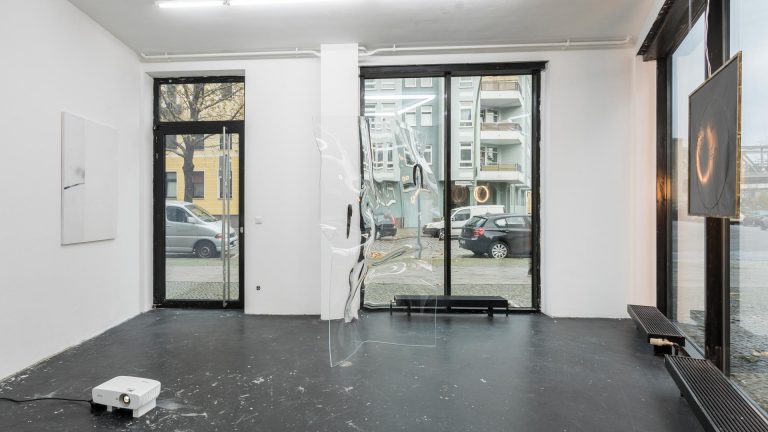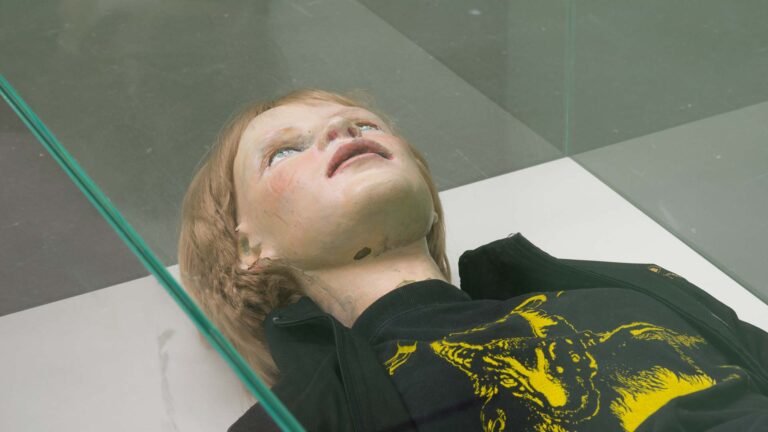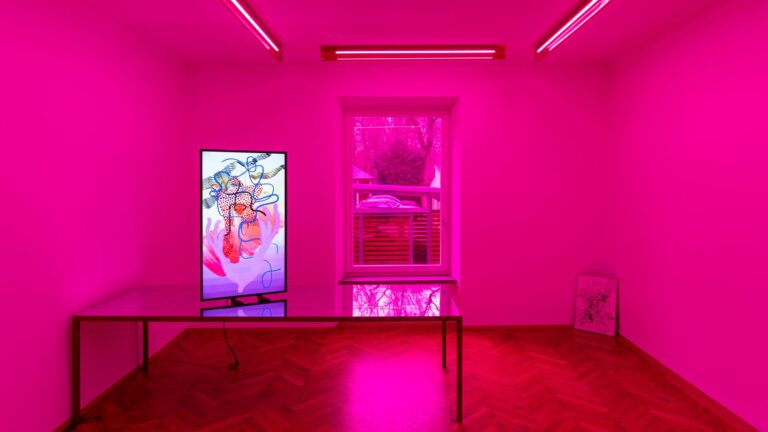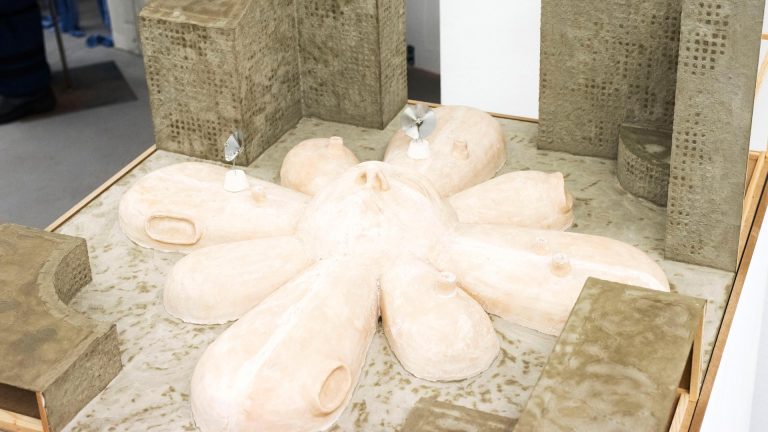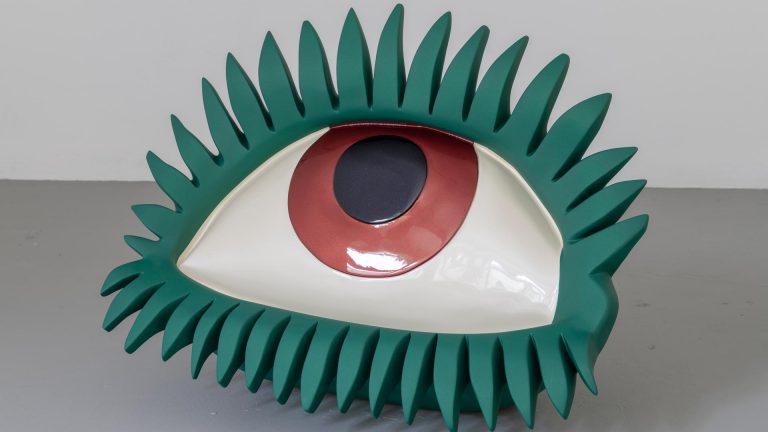Artists: Etti Abergel, Naama Arad und / and Tchelet Ram, Julie Becker, Ursula Burghardt, Noa Glazer, Omer Halperin, Gizela Mickiewicz, Oren Pinhassi, Michal Samama, Nora Schultz, Noa Schwartz, Lior Shachar
Exhibition title: Guilty Curtain
Curated by: Naama Arad and Nikola Dietrich
Venue: Kölnischer Kunstverein, Cologne, Germany
Date: August 21 – October 24, 2021
Photography: all images copyright and courtesy of the artists and Kölnischer Kunstverein
Guilty Curtain is a site-specific installation made for the historical space of the Kölnischer Kunstverein. Inside the long transparent exhibition hall, a group show will take the form of a glass house. The artworks on display all rely on surrealistic no tions like covering and/or replacing. These gestures, performed by artists on various objects and materials, do not end at a cul de sac. The wrapping of a toaster oven in sheep’s wool uncovers an entangled relationship—instead of the sheep being placed in the oven, the oven is devoured by the sheep. This mixture of material, words and categories alludes to a symbiotic relationship between the body and the object. While the modernist attempt to dissolve separations between inside and out side only ended up emphasizing the divide, what is disclosed through the collection of all these bodily objects undermines the architectural structure of the Kunstverein itself; as one will experience space, in this particular glass house nature is no longer an exterior.
The extensive group exhibition and event series brings together artists mainly from Israel with others from Poland, Germany, and the USA. In close cooperation with the Israeli artist and curator Naama Arad, a local and active art scene, which has formed mainly in Tel Aviv, will be presented at the Kölnischer Kunstverein in Cologne.
Etti Abergel (b. 1960 in Tivon, lives in Tivon and Jerusalem) creates autobiographical site-specific installations which draw upon her experience as the daughter of immi grants from Morocco who arrived in Israel in the 1950s. By using objects that sym bolize significant memories, she builds a visual language that binds and combines these symbols in a physical space. They speak of difference, contradictions, unre solved identity, and the need to control desires by taking the shape of objects that undergo constant metamorphosis. At the same time, her work is about slowness as it acquires meaning during a spontaneous and often unconscious process of crea tion. Her multifaceted iconography results from a complex system of associations that gradually take shape, constantly moving between harshness and poetry. In her own words, “I try to give a body to the abstract memory to recreate the inner experi ence, to recover the essence of the moment of feeling.” This “moment of feeling” can be understood as a trauma. The artist participated in the international exhibi tion Clandestines curated by Francesco Bonami as part of the 50th Venice Biennale in 2003.
Naama Arad (b. 1985, lives in Tel Aviv) is a sculptor, installation artist, and curator whose work transgresses structures of power and authority such as language, architecture, history, and gender. Often revolving around notions of attachment and connectivity, Arad’s work proposes a materialistic and semiotic mixture enmeshing the body with the object. As everyday mass-produced objects connect into symbiotic arrangements, new complementary encodings and meanings emerge. In recent years, Arad has expanded her artistic practice into curatorial work. Using artworks as ready-made or as found objects, Arad’s curated exhibitions seek to re-exhibit existing artworks within new constellations.
Tchelet Ram (b. 1982, lives in Tel Aviv) is an installation artist and sculptor whose works are constructed and displayed in both traditional white cubes and diverse alternative locations. Merging a real space with an abstract imaginary place, Ram’s environments play with ideas of dwelling as they expand the form of what is tradi tionally considered a habitat. Her sculptural assemblages appropriate found objects such as her friends’ artworks, discarded furniture found on the street, or her own family heirlooms. Those are used by the artist to construct a dysfunctional living environment which invokes both the practical and senseless characteristics of life. In this sense, the power of Ram’s artworks lies in her ability to give form to the unfathomable gap between what exists and what is missing.
The exhibited works were made collaboratively by Arad and Ram in a desire to con sider artworks as the result of an intersubjective encounter while seeking to stretch boundaries and bridge divisions each other. The various sculptures in the show draw a gradient of bodiliness across the exhibition space to fuse the world of mankind and that of nature. It is in this unity where categories are blurred and the separation between human and animal dissolves.
Julie Becker (b. 1972 in Los Angeles, d. 2016 ibid.) explores in her installations, photo graphs, sculptures, drawings, and videos the human psyche between a supposed idyll and security of the 20th-century American dream and loneliness, alienation and social inequalities that underlie late capitalism. Becker draws from sources of the uncanny, fantastic, and (night)dreamlike as diverse as Stephen King, Kay Thompson, and Walt Disney. Her architectural, intimate spaces and miniature models are at once domestic sanctuary and anxiety space. Reflecting on her own personal experi ence of precarious living, the artist investigated the psychologically charged spaces, in which built scale models or staged photographs—as in the exhibited works Interior Corner 3 and 5—turn into sites of refuge and fantastical escape.
Ursula Burghardt (b. 1928 in Halle/Saale, d. 2008 in Cologne) was born to a Jewish family in Halle an der Saale. In 1936, the family fled from the National Socialists and emigrated to Argentina. She returned to Germany in the 1950s and lived and later worked in Cologne, during a time when a lively art scene had established itself from the 1960s onwards with Fluxus, conceptual art, and feminist movements. Her abstract sculptures made of metal, zinc, and aluminum reveal Burghardt’s roots in minimalism and experimental art and show the tension between bourgeois conven tions and new artistic approaches. In addition to metal objects, she also created sculptures in wood and glass as well as partly real, partly surreal collages, drawings, and picture books for adults, in which she sharply and subtly alluded to her own role as an artist and as a woman.
Noa Glazer’s (b. 1981, lives in Pardes Hanna) objects and materials tend to expand beyond their respective boundaries—not in pursuit of representation or symbolic repair, but rather by forming them into loops around new absences of themselves— conductive loops that depict absence as regions of displacement. Materials—each with their own inherent pattern—stand fixed in a disarray of static beliefs. Against this background, Glazer, by means of collecting and haptic intervention, both con fides in and betrays the familiarity and proximity of her material surroundings (e.g., cantaloupe, mud, feral plants, a beaded car seat cover, glass, salt, etc.) to identify and reorder these configurations of disarray.
Omer Halperin’s (b. 1984, lives in Jaffa) exhibitionistic as well as intimate figures in her charcoal drawings are choreographed—both compositionally and architecturally —in luminous spaces full of fear and mystery. They bear similarities to the horror genre, which inherently deals with decay. As if in a local adaptation of the decaying ambience characteristic of “film noir,” Halperin’s figures appear slightly disturbed, almost insane; depicted in dark interiors and in manic poses, they unleash facial expressions that portray a wide range of emotions.
Gizela Mickiewicz’s (b. 1984 in Złotów, lives in Warsaw) works take as their point of reference relations between people and objects as well as the ways in which we remember through the tangible things that surround us and how we modify our identity and emotions living amongst and, sometimes, for things. The work exhib ited here focuses on showing the multitude of possible perspectives on the same situation; it is an attempt to show the uniqueness of every person’s perception. Its appearance depends on the angle from which one looks at it and the circumstances —what is within its visual range. There is no hierarchy of sightlines, no preference for any of the ways of looking at it. Its character is perishable, dynamic—it changes with the appearance of the surroundings, but also influences them; the sculpture as a reflection of the surrounding.
Oren Pinhassi (b. 1985 in Tel Aviv, lives in New York City) works primarily with architectural materials such as steel, plaster, sand, concrete and glass. His tactile sculptures oppose the reductive logic of binaries—the logic of things being either this or that—practicing instead a logic of simultaneity and of ambiguity. In the work In the work on display a simultaneity of categories overlaps with a simultaneity and ambiguity of language and of our desires. The work consists of ready-made umbrel las that split and come together as a petrified, concrete tree. Domestic toothbrush cup-holders emerge like industrial fruits from this tree, suggesting both the inflow and the exit of liquids into and from the body. One cup is located at hand-reaching height, the other at the height of the pubic area. In Hebrew, ‘one in the mouth and one in the heart’ means that what a person says is not equal to what they mean or feel in their heart. This duality that exists in language and in human desire, and the tension between coherent appearance and hybridity, is at the heart of this work.
Michal Samama’s (b. 1977, lives in Tel Aviv) work Lament of Plastic brings together the performer’s body and a plastic garbage bag in an ambivalent dynamic of accept ance and resistance. As they interact, the garbage bag becomes a space, a dwelling, a container for the body, and a territory for it to protect. But the movement of the body on the bag also produces disturbingly loud sounds, evoking a range of invisible figures. While plastic garbage bags are at the end of the consumption process, used to contain and then get rid of all the leftovers of our culture, here it is inflated with air again and again, losing and regaining its “breath of life.” Samama’s perfor mance work is rooted in body and movement, in the tension between the static, visual image and the live, breathing, transforming body. Her work moves between the gallery, the theater, and the public space, exploring the ways by which these spaces and their conventions frame the body. The artist works with generic objects, items of vulgar consumption, made invisible to us by their everydayness and their insignificance.
Nora Schultz (b. 1975 in Frankfurt/M., lives in Boston) Everyday objects, language, recording systems, and cultural shifts play a role in Schultz’s work, as does the observation and critical involvement of the exhibition space and the artist herself as producer of the work that often takes over and activates a place beyond the exhibition space. In her work Soundcrust 4 a GoPro camera was used as automated “co-producer” whose contribution to the creative process Schultz, however, cannot fully control as it has its own dynamics and con stantly questions the position of the artist/author during its use. Not an Ear 1 and 2 are drawings of two “ears” threaded with wire. They are drawn in a way that the insides and outsides of the form follow each other and are sometimes perspectively confused, so that a hollow part could also turn into the outside of the “shell.” They are also kind of loose doodles, in-between an attempt to formally represent ears and, at the same time, to undo this and turn them into more general abstract drawings. Live sounds from the the Kunstverein’s environment connect all her works: Certain powerful things can be heard with a regularity (trains, a clocktower), others appear more sporadically and particular (people talking, birds, cars, trucks, an alarm). The room turns into an amplifier that indicates a twofold reality outside the windows.
Noa Schwartz (b. 1988 in Tel Aviv, lives ibid.) is a sculptor and installation artist working with objects and materials of daily life and her immediate surroundings. These include the city of Tel Aviv, its urban nature and architecture as well as her own personal life and domestic surroundings. The work Window consists of two round glass windows installed so they overlap. Fixed together to the wall, this pair cannot be made functional as their potential synchronization might end up in a clash. Nutrisource is a cast of her cat’s water and food bowl made from plaster mixed with sand from Israel. Casting the work in building materials references the city of Tel Aviv, its local Bauhaus aesthetic, and its many stray cats.
Lior Shachar’s (b. 1986, lives in Tel Aviv) works deal with decoration driven by “tastelessness,” exploring graphic representations and manual renderings of digital signs. Some of Shachar’s objects contain banal texts and images which refer to amateur craft as it appears in public spaces (for example in local storefronts). Both works exhibited here echo nature and the outside as it is rendered through illustra tive modes of representation. The work A Trap alludes to information panels for tour ists as it presents a collection of photographs taken on the artist’s cellphone and printed as postcards. The work Untitled (Fire) refers to an Israeli tradition of throwing potatoes wrapped in foil into the fire on the occasion of the Jewish holiday of Lag B’omer. In this piece, the wrapped potatoes are used as a pedestal for plasticine casts that serve as color charts for fire.
Guilty Curtain, 2021, Installation view Kölnischer Kunstverein, 2021, Photo: Mareike Tocha
Lior Shachar, A Trap, 2018, Installation view Kölnischer Kunstverein, 2021, Photo: Mareike Tocha
Oren Pinhassi, One in the mouth and one in the heart, 2018, Courtesy: the artist and Edel Assanti, London, Photo: Mareike Tocha
Guilty Curtain, 2021, Installation view Kölnischer Kunstverein, 2021, Photo: Mareike Tocha
Naama Arad and Tchelet Ram, In Search of Lost Time, 2020, Installation view Kölnischer Kunstverein, 2021, Courtesy: the artists. Photo: Mareike Tocha
Naama Arad and Tchelet Ram, If Looks Could Kill, 2020, Installation view Kölnischer Kunstverein, 2021, Courtesy: the artists. Photo: Mareike Tocha
Naama Arad and Tchelet Ram, Internet, 2020, Installation view Kölnischer Kunstverein, 2021, Courtesy: the artists. Photo: Mareike Tocha
Naama Arad and Tchelet Ram, Internet, 2020, Detail, Kölnischer Kunstverein, 2021, Courtesy: the artists. Photo: Mareike Tocha
Guilty Curtain, 2021, Installation view Kölnischer Kunstverein, 2021, Photo: Mareike Tocha
Naama Arad and Tchelet Ram, Venus in Fleece, 2020, Installation view Kölnischer Kunstverein, 2021, Courtesy: the artists, Photo: Mareike Tocha
Omer Halperin, Dinner, 2017, Installation view Kölnischer Kunstverein, 2021, Courtesy: the artist and Sommer Contemporary Art, Tel Aviv, Photo: Mareike Tocha
Gizela Mickiewicz, You say it’s here, I’d rather say it’s here, 2018, Installation view Kölnischer Kunstverein, 2021, Courtesy: the artist and Stereo, Warsaw, Photo: Mareike Tocha
Guilty Curtain, 2021, Installation view Kölnischer Kunstverein, 2021, Photo: Mareike Tocha
Guilty Curtain, 2021, Installation view Kölnischer Kunstverein, 2021, Photo: Mareike Tocha
Noa Schwartz, Window, 2016, Installation view Kölnischer Kunstverein, 2021, Courtesy: the artist, Photo: Mareike Tocha
Naama Arad and Tchelet Ram, The Open, 2020, Installation view Kölnischer Kunstverein, 2021, Courtesy: the artists, Photo: Mareike Tocha
Omer Halperin, Ruti, 2018, Installation view Kölnischer Kunstverein, 2021, Courtesy: the artist and Sommer Contemporary Art, Tel Aviv, Photo: Mareike Tocha
Naama Arad and Tchelet Ram, Change, 2020, Installation view Kölnischer Kunstverein, 2021, Courtesy: the artists, Photo: Mareike Tocha
Naama Arad and Tchelet Ram, Tarimi, 2020, Installation view Kölnischer Kunstverein, 2021, Courtesy: the artists, Photo: Mareike Tocha
Guilty Curtain, 2021, Installation views of works by Etti Abergel, Ursula Burghardt, Noa Glazer, Noa Schwartz, Lior Shachar, Kölnischer Kunstverein, 2021, Courtesy: the artists, Stiftung Kunstfonds, Becker-Biberstein Collection and Adrienne & Peter Biberstein, Tel Aviv, Photos: Mareike Tocha
Guilty Curtain, 2021, Installation views of works by Etti Abergel, Ursula Burghardt, Noa Glazer, Noa Schwartz, Lior Shachar, Kölnischer Kunstverein, 2021, Courtesy: the artists, Stiftung Kunstfonds, Becker-Biberstein Collection and Adrienne & Peter Biberstein, Tel Aviv, Photos: Mareike Tocha
Guilty Curtain, 2021, Installation views of works by Etti Abergel, Ursula Burghardt, Noa Glazer, Noa Schwartz, Lior Shachar, Kölnischer Kunstverein, 2021, Courtesy: the artists, Stiftung Kunstfonds, Becker-Biberstein Collection and Adrienne & Peter Biberstein, Tel Aviv, Photos: Mareike Tocha
Guilty Curtain, 2021, Installation views of works by Etti Abergel, Ursula Burghardt, Noa Glazer, Noa Schwartz, Lior Shachar, Kölnischer Kunstverein, 2021, Courtesy: the artists, Stiftung Kunstfonds, Becker-Biberstein Collection and Adrienne & Peter Biberstein, Tel Aviv, Photos: Mareike Tocha
Guilty Curtain, 2021, Installation views of works by Etti Abergel, Ursula Burghardt, Noa Glazer, Noa Schwartz, Lior Shachar, Kölnischer Kunstverein, 2021, Courtesy: the artists, Stiftung Kunstfonds, Becker-Biberstein Collection and Adrienne & Peter Biberstein, Tel Aviv, Photos: Mareike Tocha
Guilty Curtain, 2021, Installation views of works by Etti Abergel, Ursula Burghardt, Noa Glazer, Noa Schwartz, Lior Shachar, Kölnischer Kunstverein, 2021, Courtesy: the artists, Stiftung Kunstfonds, Becker-Biberstein Collection and Adrienne & Peter Biberstein, Tel Aviv, Photos: Mareike Tocha
Guilty Curtain, 2021, Installation views of works by Etti Abergel, Ursula Burghardt, Noa Glazer, Noa Schwartz, Lior Shachar, Kölnischer Kunstverein, 2021, Courtesy: the artists, Stiftung Kunstfonds, Becker-Biberstein Collection and Adrienne & Peter Biberstein, Tel Aviv, Photos: Mareike Tocha
Guilty Curtain, 2021, Installation views of works by Etti Abergel, Ursula Burghardt, Noa Glazer, Noa Schwartz, Lior Shachar, Kölnischer Kunstverein, 2021, Courtesy: the artists, Stiftung Kunstfonds, Becker-Biberstein Collection and Adrienne & Peter Biberstein, Tel Aviv, Photos: Mareike Tocha
Guilty Curtain, 2021, Installation views of works by Etti Abergel, Ursula Burghardt, Noa Glazer, Noa Schwartz, Lior Shachar, Kölnischer Kunstverein, 2021, Courtesy: the artists, Stiftung Kunstfonds, Becker-Biberstein Collection and Adrienne & Peter Biberstein, Tel Aviv, Photos: Mareike Tocha
Guilty Curtain, 2021, Installation views of works by Etti Abergel, Ursula Burghardt, Noa Glazer, Noa Schwartz, Lior Shachar, Kölnischer Kunstverein, 2021, Courtesy: the artists, Stiftung Kunstfonds, Becker-Biberstein Collection and Adrienne & Peter Biberstein, Tel Aviv, Photos: Mareike Tocha
Lior Shachar, Untitled (Fire), 2012, Installation view Kölnischer Kunstverein, 2021, Courtesy: the artist, Photo: Mareike Tocha
Guilty Curtain, 2021, Installation view Kölnischer Kunstverein, 2021, Photo: Mareike Tocha
Nora Schultz, Soundcrust 4 and Not an Ear 1 + 2, all 2021, Installation view Kölnischer Kunstverein, 2021, Courtesy: the artist and Galerie Isabella Bortolozzi, Berlin, Photo: Mareike Tocha
Nora Schultz, Not an Ear 1, 2021, Installation view Kölnischer Kunstverein, 2021, Courtesy: the artist and Galerie Isabella Bortolozzi, Berlin, Photo: Mareike Tocha
Nora Schultz, Not an Ear 2, 2021, Installation view Kölnischer Kunstverein, 2021, Courtesy: the artist and Galerie Isabella Bortolozzi, Berlin, Photo: Mareike Tocha
Nora Schultz, Soundcrust 4, 2021, Installation view Kölnischer Kunstverein, 2021, Courtesy: the artist and Galerie Isabella Bortolozzi, Berlin, Photo: Mareike Tocha
Nora Schultz, Not an Ear 3, 2021, Installation view Kölnischer Kunstverein, 2021, Courtesy: the artist and Galerie Isabella Bortolozzi, Berlin, Photo: Mareike Tocha
Michal Samama, Lament of Plastic, 2014, Installation view Kölnischer Kunstverein, 2021, Courtesy: the artist, Photo: Mareike Tocha
Guilty Curtain, 2021, Installation view Kölnischer Kunstverein, 2021, Photo: Mareike Tocha
Guilty Curtain, 2021, Installation view Kölnischer Kunstverein, 2021, Photo: Mareike Tocha
Naama Arad and Tchelet Ram, Brainstorming, 2020, Detail, Installation view Kölnischer Kunstverein, 2021, Courtesy: the artists, Photo: Mareike Tocha
Julie Becker, Interior corner #3 and #5, 1993, Installation view Kölnischer Kunstverein, 2021, Courtesy: Private collection, Photo: Mareike Tocha
Noa Schwartz, Nutrisource, 2020, Installation view Kölnischer Kunstverein, 2021, Courtesy: the artist, Photo: Mareike Tocha











































